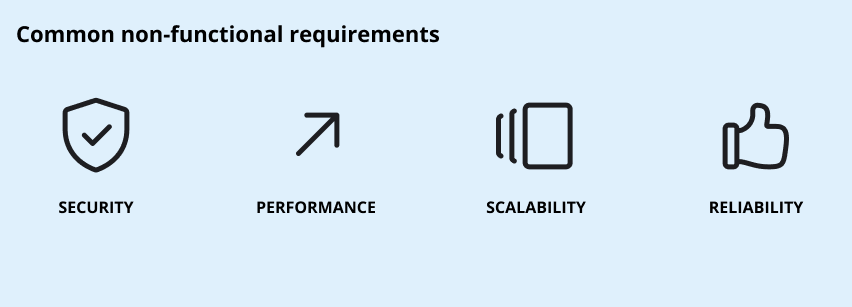In this post, you will learn about technical analysis in software engineering and the role of a tech lead/technical expert and solution architect in the software development process.
You already know about the importance of Business Analysis (BA) in software development. It’s hard to overestimate the role of a business analyst who helps formulate and translate stakeholders’ requirements, align expectations, and as a result, launch a valuable software product.
However, there’s another major analysis in software development that helps create successful products and deliver a project effectively. This analysis is called technical analysis or technical investigation and is usually fulfilled by a tech lead, solution architect or other tech experts in the team.
What is technology analysis in software development?
As you know, business analysts work on functional requirements, whereas the responsibility of solution architects is to conduct technology analysis: define an integration strategy, find the right platforms and frameworks for the future system and document non-functional requirements.
So what is technology analysis and what does the process of technical investigation include? To put it simply, technology analysis is the process of assessing technologies and tools that could/would be used to develop a digital system. It is usually performed by senior tech specialists who use technical investigation to select an optimal tech stack and development approach based on project requirements and goals.
Read: Discovery Phase in software development
Common technology analysis methods
Depending on the stage and specifics of the project, engineers and architects use different technology analysis methods and processes:
- Analyze project requirements
- Break down the system into functional components to analyze each module
- Gather insight and list available technologies, platforms, frameworks, tools that could be used to develop each component (search, peer experience, documentation, professional forums and domain-specific resources, etc.)
- Review relevant open-source and/or proprietary libraries, APIs, prototypes, etc.
- Make a comparative analysis of technology alternatives based on key criteria (license, price, availability, reliability, performance, code quality, support, scalability, flexibility, etc.)
- Determine risks and define limitations
Are you looking for a skilled cross-functional team to select an optimal tech stack for your project and help you with modernizing an existing or building a brand new digital system? Check our scoping workshop offer and contact our team to discuss your software project requirements and needs.
Key steps of information technology analysis
Here are the key steps to make during technical analysis in software development.
Analyze the client’s technology infrastructure
Almost every client has at least some technology infrastructure to start with. By infrastructure, we usually imply hosting, email services, SSL certificates, database servers and any other technology component on the client’s end that will interact with the future system.
In order to understand how to work with the given infrastructure, a tech lead performs the technical investigation and tries to understand how to further use this infrastructure in designing and building a new system or upgrading existing software.
Usually, if the existing infrastructure is well-built and compatible with a new product, it can be completely re-used. Sometimes, the legacy systems are simply too old and won’t go along with a new product. Then, such infrastructures require a complete upgrade. If this is the case, it’s good to learn about it at the very beginning of the project to implement relevant prioritization of project requirements.
At this stage of information technology analysis, tech leads or solution architects also try to find out how to integrate the client’s services into a new system.
In a common technology analysis example, experts and analysts need to figure out how to integrate a new client application with the old infrastructure and database. For instance, when a company needs to develop a new app for customers that will be using their old backend. In this case, a technical analyst should define the capabilities and limitations for such integration. It is worth discussing the integration opportunities with a backend development team in the first place. In some cases, when direct integration is impossible, the scope may include the development of a private REST API to connect the backend with the app.
Make a technological analysis of solutions and platforms used to build a new system and its components
There is no point in reinventing a wheel. Custom software should benefit from a wide range of platforms, frameworks and services available in the market.
For example, we are building an app or a website that should display certain content managed by an admin. This app or website may be stuffed with custom unique features which require serious design and development efforts. However, adding the component responsible for content management is a no-brainer. Today, it can be built on top of a time-proven CMS platform such as WordPress, Sitecore, etc.
Read: Benefits of Flutter for MVP development
There are plenty of examples when platform integration actually speeds up the development. Different CRM systems, eCommerce platforms, mail services are among the most common out-of-the-box solutions used and customized for these purposes. The main task of a technology expert at this stage is to find and compare potential third-party software solutions, validate them against given business requirements and choose the right ones for the project.
Analyze third-party APIs required for the development
Nowadays, almost any new system requires certain integrations. It can be a payment gateway, social networks or domain-specific services and platforms usually integrated via API.
Sometimes, the list of API is provided by the client. Often, it’s the responsibility of a tech lead to finding an appropriate library or framework that can be useful in the course of the project development.
For this purpose, it’s useful to dig through the Internet, choose the most popular libraries or other solutions in a specific business domain, study the approaches competitors of other companies use to solve similar problems and learn from the experience in the company.
When defining the list of libraries, APIs or frameworks that could be used in the project, tech experts should know how to compare software solutions. Once the final list of integrations is defined, tech specialists perform the technological analysis that usually consists of the following steps:
- Reviewing relevant documentation,
- Matching endpoints/features and product requirements,
- Analyzing how these solutions could be used in the future (important for the features, which are out of the project’s scope now but can be included later)
- Validating API, framework, platform or other solutions’ limitations against the given requirements,
- Validating API, framework, platform or other solutions’ performance capabilities against the given requirements/established project goals,
- Analyzing how to integrate API, framework, platform or other solutions in the existing infrastructure.
Document non-functional requirements
As a rule, business analysts discuss business goals and requirements with a client. Technology analysts, in turn, collect and document non-functional requirements.

Non-functional requirements are abundant. The most common and important ones are the following:
Security
Security requirements include:
- protection against unauthorized access to the system and its data,
- authorization and authentication across different user roles,
- data privacy,
- prevention and protection against cyber attacks and malware.
Reliability
This requirement determines the ability of a system to perform under certain conditions in a certain environment. It includes:
- consistent system performance without failure for a period of time,
- the impact of bugs, hardware malfunction, other problems with system components,
- the quality of task implementation.
Performance
Performance measures the quality of system interaction with users. It includes:
- user experience quality,
- system safety against overloads,
- system responsiveness to different user interactions.
Scalability
These requirements imply system growth capacity. It includes:
- the ability to provide more users with a service of the same quality,
- processing more data or transactions,
- the capacity for memory, space, speed growth.
These are the important non-functional requirements for almost every software development project. If these requirements are not taken into consideration during technology impact analysis and technical investigation at the beginning of a project, it entails serious risks which may end up with additional costs and time loss.
Results and deliverables of technical investigation
When tech leads or solution architects are done with all the steps of technical investigation and IT analysis, they record the results and create the following artifacts:
- Technology stack description. This description includes the programming languages, databases, servers, hosting and third-party libraries recommended to use on the project.
- The architectural diagram of a product. Usually, the diagram shows different project components with their roles and functionality and the relations between different components of the future system.
- Non-functional requirements specification. This is a separate part of the functional specification which describes non-functional requirements – security, reliability, scalability, performance, etc.
Technology analysis with Digiteum
The success of your software project depends greatly on the choice of technologies, architectural style, and a range of digital services involved in project development and support. In-depth technology analysis is an important instrument that helps your tech team develop scalable systems, leverage advantages of microservices and other modern web app architecture styles, and work out future-proof product strategies.
Leverage our 14+ years of experience in building high-load web applications, cloud-based systems, big data solutions, and user-centered digital products on your project. We have full-stack teams, in-house UX and product design experts, solution architects, and dozens of senior and lead engineers (including senior full-stack engineers, senior .NET engineers, Java application developers, big data engineers, etc.) who will help you analyze your requirements and choose an optimal technology stack for your systems.
Final thought
I believe a balanced combination of business and tech analysis leads to the excellence of a software development process and a final product. In my experience, the more thoughts you put into the future system at the beginning of the project, the easier and faster the development will go and the better results you get in the end.
In this post, we have answered a few important questions about technology analysis, such as “what is technological analysis?” and “what are the key steps of technical investigation?”. If you want to further explore this topic, check a step-by-step guide from Digiteum CTO on how to compare software solutions, libraries, frameworks or other components.
Working on an MVP for web and looking for a skilled team to help you bring your product to life? Check our MVP development services and contact our team to get a free quote.








